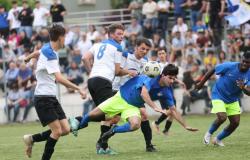Boeing’s first crewed space flight was scheduled for launch on Tuesday, local time, but the company now says it will be at least 10 days before lift off from Cape Canaveral in Florida.
The CST-100 Starliner test mission was postponed 24 hours before launch over a technical issue with its Atlas rocket, which will be rolled back to its hangar to replace a pressure valve.
There was no issue with the reusable astronaut capsule which sits on top of the rocket.
The new date for the mission — pivotal to Boeing’s struggle to acquire a greater share of lucrative business now dominated by Elon Musk’s SpaceX — was set for May 17 at the earliest, according to NASA.
This cancellation follows two years of delays in launching with a crew.
What is the mission?
The CST-100 Starliner test mission will take two NASA astronauts to the International Space Station (ISS).
The crew’s arrival at the ISS will be the final demonstration before the spacecraft can be approved to fly routine space trips under NASA’s commercial crew program.
It took two years for Boeing to get to this point, completing its first test voyage to the orbital laboratory without astronauts aboard two years ago.
As the final flight test for Starliner, NASA’s Boeing Crew Flight Test will validate the transportation system, including the launch pad, rocket, spacecraft, in-orbit operational capabilities, and return to Earth with astronauts aboard.
If all goes as planned, the capsule will arrive at the space station after a flight of about 26 hours and dock with the orbiting research outpost some 400 kilometers above Earth.
Who is on board?
Riding the Starliner are veteran NASA astronauts Barry “Butch” Wilmore, a 61-year-old retired US Navy captain and Sunita “Suni” Williams, a 58-year-old former Navy aviator and test pilot.
Williams has experience flying over 30 different aircraft, and has logged 322 days in space over two missions since her first flight in 2007.
She also ran the first marathon in space during that first mission.
Wilmore has logged 178 days in space since his first of two space missions in 2009.
Wilmore is the designated commander for the flight, with Williams in the pilot seat.
Although Starliner is designed to fly autonomously, the crew can assume control of the spacecraft if necessary.
The test flight calls for Wilmore and Williams to practice maneuvering the vehicle manually.
What happens when they get to space?
If all goes to plan, Williams and Wilmore will be welcomed aboard the ISS by its seven-member resident crew, currently consisting of four US astronauts and three Russian cosmonauts.
Wilmore and Williams are expected to remain at the space station for about a week before riding the Starliner back to Earth for a parachute and airbag-assisted landing in the New Mexico desert — the first time NASA has used that landing method.
What does this mean for Boeing?
Boeing’s commercial aircraft operations are in disarray after several sequential crises.
It badly needs a space win for its Starliner venture, a years-delayed program with more than $US1 billion in cost overruns.
While Boeing has struggled, Musk’s SpaceX has become a dependable taxi to orbit for NASA, which is backing a new generation of privately built spacecraft that can ferry its astronauts and other customers to the ISS and, under the space agency’s more ambitious Artemis program, to the Moon and eventually Mars.
Starliner would compete head-to-head with SpaceX’s Crew Dragon capsule, which, since 2020, has been NASA’s only vehicle for sending ISS crew to orbit from US soil.

The first attempt by Boeing to send an uncrewed Starliner to the space station in 2019 failed because of dozens of software and engineering glitches.
A second attempt in 2022 succeeded, paving the way for this mission.
Depending on the outcome, Starliner is booked to fly at least six more crewed missions to the space station for NASA.
The test flight comes at an especially critical moment for Boeing.
Its airplane business is dealing with fallout from a midair blowout of a cabin panel door plug on a nearly new 737 MAX 9 in January, as well as previous deadly crashes of two 737 MAX jets.
ABC/Wires
Posted 10h ago10 hours agoTue 7 May 2024 at 7:17pm, updated 2h ago2 hours agoWed 8 May 2024 at 3:00am







